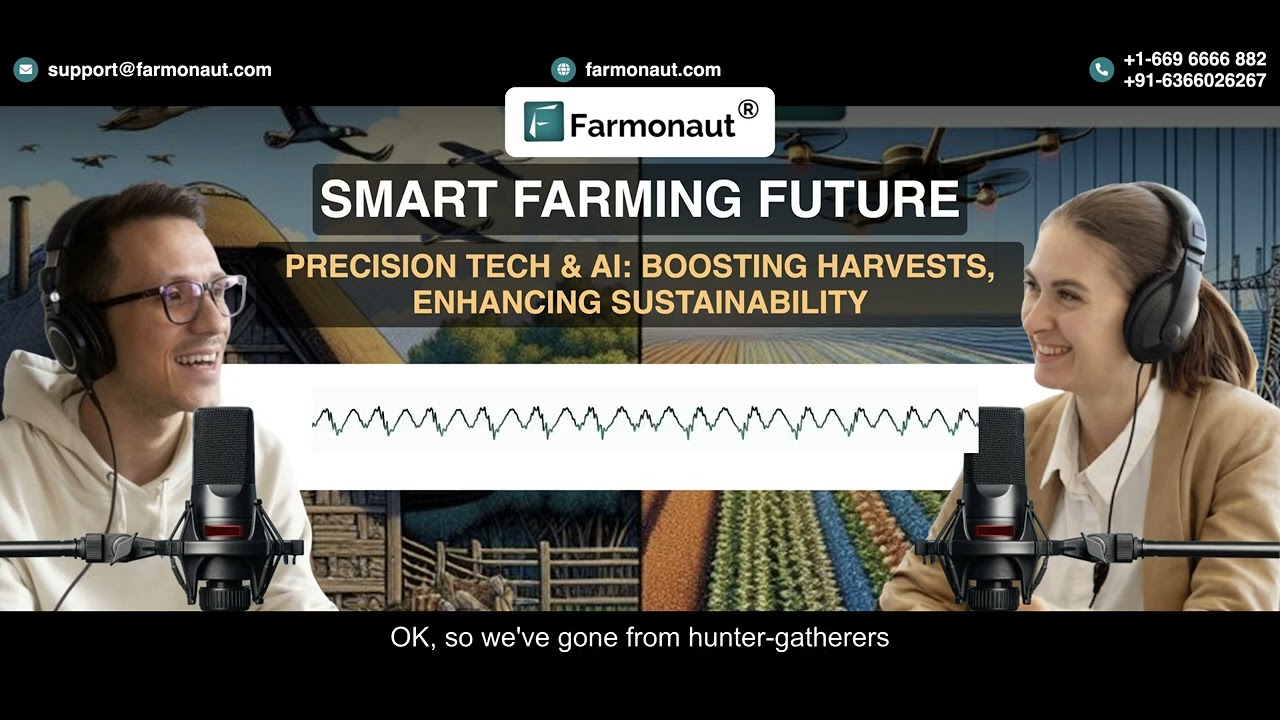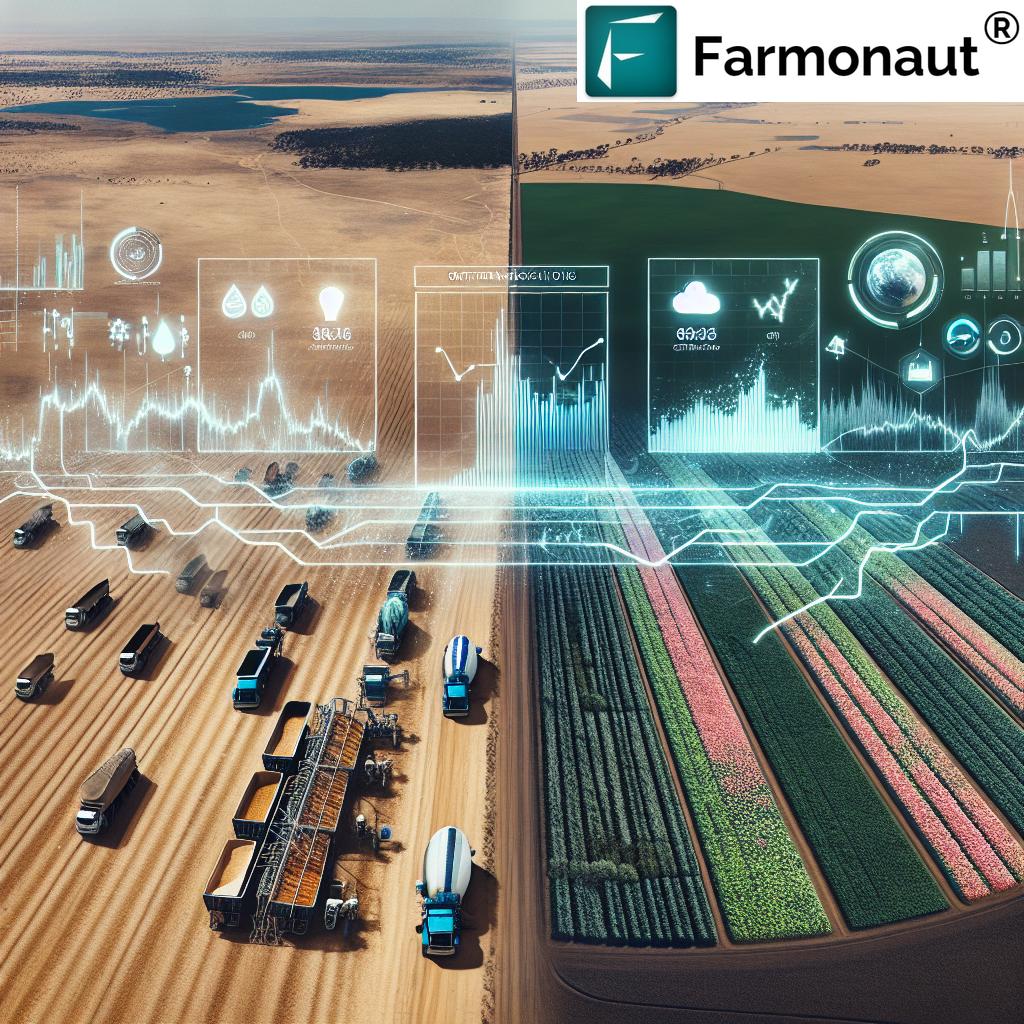Agriculture Jobs in Australia 2025: Top Farming Roles
“By 2025, over 300,000 Australians are projected to work in agriculture, with tech-focused roles rapidly increasing.”
- Overview of Agriculture Jobs in Australia 2025
- Emerging Trends Affecting Farming Jobs in 2025
- Top Agricultural Roles: What’s In Demand Across Australia?
- Trends & Projections Table for Top Agriculture Jobs (2025)
- Technology Integration and Precision Agriculture
- Sustainability: The Future of Farming Jobs in Australia
- Climate Challenges, Adaptive Skills, & Climate-Smart Solutions
- Labor Shortages, Migration and Workforce Opportunities
- Skill Development, Training, and Education Pathways
- Farming Innovation, Diversity & Rural Community Impact
- Satellite Technology & Farmonaut’s Role in Agriculture Jobs
- FAQ: Agriculture Jobs in Australia 2025
- Conclusion: The Future Landscape of Farming Jobs in Australia
Overview of Agriculture Jobs in Australia 2025
When we look at agriculture jobs in Australia for 2025, we find a dynamic and essential sector, serving as the cornerstone of the nation’s economy. Not only does this sector provide vital food and resources both domestically and for export, but it also creates a wide range of employment opportunities, from traditional farmhands to advanced technology roles.
The landscape of agriculture jobs australia continues evolving in 2025 due to technological advancements, climate challenges, and shifting labor market demands. This evolution is shaping the future of farming jobs across the country, requiring a blend of traditional knowledge and advanced digital skills.
- The sector remains one of the largest employers, supporting hundreds of thousands of workers both directly and indirectly.
- Roles span a diverse range – from machinery operators, farmhands, agronomists, livestock managers, horticulturists, to agribusiness professionals.
- The industry also relies heavily on seasonal workers during intense planting and harvesting seasons.
- Key commodities – such as wheat, barley, sugarcane, cotton, wool, and cattle – underpin the ongoing demand for these jobs.
- Due to Australia’s vast geography, farm roles are found in a variety of settings:
- Broadacre grain farming in Western Australia
- Dairy and horticulture in Victoria and New South Wales
With 2025 on the horizon, agriculture jobs in Australia are being influenced by emerging trends, technology integration, evolving sustainability practices, and labor market shifts.
Emerging Trends Affecting Farming Jobs in Australia 2025
As the agriculture sector faces new opportunities and challenges, several emerging trends are shaping farming jobs australia for 2025 and beyond:
-
Technology Integration:
Precision agriculture driven by drones, GPS mapping, IoT sensors, and data analytics is redefining traditional roles.
Skillsets required today include familiarity with digital tools, ability to interpret data, and a focus on resource efficiency and crop yields.
-
Sustainable Practices:
Environmental sustainability is a growing priority, prompting the adoption of regenerative agriculture, water conservation, and soil health management. Jobs increasingly require expertise in sustainable practices and ecological stewardship.
-
Labor Shortages and Migration:
Despite high demand for agriculture jobs australia, labor shortages persist, particularly for seasonal roles. In response, the Australian government is pushing visa reforms and initiatives to stabilize the workforce via skilled migration and apprenticeships.
-
Climate Resilience:
Accelerating climate variability is challenging productivity and job stability. Adaptive farming techniques, including drought-resistant crops, now require ongoing training and upskilling as part of every agricultural role.
Top Agricultural Roles: What’s In Demand Across Australia?
The demand for agriculture jobs in Australia is strongest in roles that blend hands-on experience with tech-driven skills and sustainability knowledge. Let’s explore the top farming jobs Australia set to see the highest opportunities and growth in 2025:
- Precision Agriculture Technicians – Implement and maintain advanced sensors, drones, and GPS-driven equipment optimizing crop yields.
- Sustainable Farm Managers – Oversee integration of regenerative & climate-smart practices, soil health, water efficiency, and carbon tracking.
- Agronomists & Advisors – Provide scientific advice on crop rotation, soil improvement, and pest management utilizing data-driven solutions.
- Livestock Managers – Manage animal health, breeding, and welfare using IoT and smart monitoring systems.
- Robotics/Machinery Operators – Handle latest agricultural robots, autonomous tractors, harvesters, and maintain digital equipment.
- Horticulturists & Viticulturists – Lead fruit, vegetable, and vineyard production using sustainable systems, especially in Victoria and New South Wales.
- Agribusiness Professionals – Specialize in supply chain management, export, finance, and blockchain traceability.
- Biosecurity & Environmental Managers – Develop systems for pest, weed control, and compliance with international food safety standards.
- Seasonal Crop & Farm Laborers – Essential during planting and harvesting seasons for a range of broadacre and horticultural farms.
Notably, grain farming in Western Australia and horticulture in Victoria and New South Wales continue as key drivers of job availability.
“Sustainable farming is set to create 15% more agriculture jobs in Australia by 2025 compared to 2020.”
Key Commodities and Job Hubs
- Wheat, barley, and broadacre crops (Western Australia, South Australia, New South Wales) – Demand for machinery operators, agronomists, and harvesting specialists.
- Dairy and horticulture (Victoria, New South Wales) – Ongoing need for livestock managers, horticulturists, and sustainable farm practitioners.
- Sugarcane & cotton (Queensland, New South Wales) – Key roles for crop management, machinery technicians, and environmental advisors.
Trends & Projections Table for Top Agriculture Jobs (2025)
| Job Role | Estimated Openings (2025) | Projected Growth Rate (%) | Key Skills Required | Relevant Technology / Innovations |
|---|---|---|---|---|
| Precision Agriculture Technician | 3,000+ | 18% | GIS, IoT setup, drone operation, data analytics | Drones, IoT sensors, satellite imaging, AI platforms |
| Sustainable Farm Manager | 4,500+ | 16% | Regenerative practices, soil & water management | Carbon tracking, irrigation tech, decision systems |
| Agronomist | 2,700+ | 13% | Crop rotation, soil testing, pest control advice | Satellite monitoring, AI-driven insights |
| Robotics Operator | 1,200+ | 22% | Robotics software, equipment maintenance | Autonomous tractors/harvesters, AI robots |
| Livestock Manager | 2,000+ | 10% | Animal health, IoT monitoring, breeding | Wearable sensors, smart tagging, health analytics |
| Horticulturist / Viticulturist | 2,600+ | 12% | Plant science, irrigation, sustainable systems | Climate forecasting, disease mapping |
| Agribusiness Professional | 2,250+ | 15% | Supply chain, finance, blockchain | Traceability platforms, blockchain, digital logistics |
| Biosecurity/Environmental Manager | 900+ | 14% | Compliance, pest/weed risk, environmental monitoring | Satellite data, risk modeling, compliance tech |
Technology Integration and Precision Agriculture Jobs in Australia
The integration of technology is a defining force redefining agricultural jobs in Australia. Precision agriculture is not just a buzzword—it’s a necessity for reaching resource efficiency and sustaining global food demand amidst climate uncertainty.
- Drones are now commonplace for crop health monitoring and precision pesticide application.
- IoT sensors and GPS mapping allow real-time data collection on soil conditions, moisture levels, and machinery operation.
- AI-driven platforms analyze farm data to forecast yields, detect pests, and optimize resources.
Check out our Carbon Footprinting solution. It uses advanced satellite data to track emissions and sustainability efforts, benefiting farm managers and agribusiness decision-makers.
Job roles such as “Precision Agriculture Technician” and “Robotics/Machinery Operator” are expanding rapidly. The required skills now include digital literacy, ability to interpret analytics, and familiarity with remote monitoring tools.
- For those looking to build a competitive edge, learning about satellite crop monitoring is recommended.
- Roles in data interpretation, AI model usage, and drone maintenance are in high demand for 2025.
All these technologies have shaped the development of digital and remote work solutions. For example, Farmonaut’s large-scale farm management tools allow managers and technicians to monitor operations, track field conditions, and receive AI-driven suggestions via satellite data—across distances, and in real time.
Want tighter integration? Developers and tech-focused agribusinesses can use the Farmonaut API (see the Developer Docs) to bring satellite-driven analytics and farm management directly into their digital workflows or custom apps.
Sustainability: The Future of Farming Jobs in Australia
Sustainable farming is reshaping agriculture jobs in Australia, driving employment growth and innovation. As sustainability becomes central to government policy and consumer trust, practices such as regenerative agriculture, carbon farming, and resource traceability grow in importance:
- Job roles now require knowledge of environmental impact analytics and ability to implement low-emission, sustainable systems.
- Regenerative practices like cover cropping, no-till farming, rotational grazing, and perennial systems are becoming farm standards, especially for sustainable farm managers and advisors.
- Understanding carbon footprint tracking and reporting is a sought-after skill. Farmonaut’s carbon footprinting solutions help both producers and corporate buyers in monitoring, benchmarking, and communicating reductions.
- Supply chain and food safety compliance means roles in blockchain-based traceability are emerging, especially for those in processing, agribusiness, and exports. Explore traceability solutions to see how this innovation can set you apart.
The employment outlook for sustainable farming jobs in Australia continues to brighten, especially as food buyers and international markets demand proof of ethically and sustainably produced goods.
Climate Challenges, Adaptive Skills, & Climate-Smart Solutions
Climate variability, including extreme weather, drought, and pest outbreaks, remains a top concern for the Australian agriculture sector. Farming jobs in Australia in 2025 require adaptive skills and a willingness to engage in ongoing training:
-
Adaptive farming is taught via professional development programs, focusing on:
- Drought-resistant and heat-tolerant crop varieties
- Water-saving irrigation systems
- Rapid response to pest/disease threats (often using AI forecasting tools)
- Data-driven decisions to offset unpredictable conditions
- Climate-smart positions such as environmental and resource management advisors are seeing fast-paced growth.
- With technologies provided by companies like Farmonaut, satellite data and real-time analytics are used to monitor soil moisture, vegetation stress, and field-level changes. This data empowers the workforce to take swift, targeted action, protecting yields and reducing losses.
- To future-proof your career, invest in learning how to use large-scale farm management solutions that combine satellite insights with farm operations.
Labor Shortages, Migration and Workforce Opportunities
Despite being the cornerstone of the Australian economy, agriculture jobs in Australia often remain vacant due to seasonal labor shortages, especially for planting, picking, and harvesting jobs. In 2025, government initiatives are boosting skilled migration and apprenticeship schemes to help stabilize the sector’s vital workforce.
- Short-season, high-labor crops—including fruits, vegetables, and cotton—create peaks in job demand.
- Backpackers and international visa-holders traditionally account for a significant share of seasonal employment, but the Government is now also focusing on local skills training for rural Australians.
- Current reforms include increased migration incentives for skilled farm workers and new pathways for on-the-job learning.
- Farm management and agribusiness roles increasingly require a mix of traditional agriculture skills and soft skills for leadership, resource management, and problem-solving.
For those interested in improving rural logistics and resource allocation, fleet management solutions empower smart vehicle and equipment deployment—reducing downtime, improving safety, and saving both costs and resources for farms and agribusinesses.
Skill Development, Training, and Education Pathways for Agriculture Jobs in Australia
To meet the ever-changing demands of farming jobs Australia, the sector is increasingly emphasizing vocational education, upskilling, and technical training.
Modern agricultural education focuses on preparing the workforce for roles driven by technology, sustainability, and business management.
- VET providers (TAFE and RTOs) are rolling out new courses in precision agriculture, digital farm management, and agri-business analytics.
- Universities continue offering programs in agronomy, environmental science, and agricultural economics, preparing skilled professionals for specialist roles.
- Ongoing, on-the-job training is now standard for many machinery-related and technology integration roles.
- Farmonaut’s knowledge resources and advisory solutions support self-learners and existing professionals seeking the latest in remote sensing and AI-based farming techniques.
Farming Innovation, Diversity & Rural Community Impact
Diversity and innovation go hand-in-hand in agriculture jobs Australia for 2025:
- Programs to promote women, youth, and Indigenous Australians into agriculture jobs continue to grow, making rural workforce more dynamic and resilient.
- With jobs supporting rural communities, investments in housing, education, and social services remain fundamental to attracting and retaining workers.
- Diversity in background and training enhances problem-solving, innovation, and sustainability practices – key for future growth.
- Farmonaut platform features, like blockchain traceability and remote monitoring, help fulfill compliance and transparency needs required by global food buyers, positioning Australian farms ahead in export and compliance markets.
Learn more about how product traceability benefits agribusinesses here.
Satellite Technology & Farmonaut’s Role in Agriculture Jobs Australia
As agricultural jobs in Australia advance toward a more digital and sustainable future, satellite technology is at the heart of many breakthroughs. We at Farmonaut believe that satellite-driven insights and AI advisory systems will become standard tools for the farming workforce. Here’s how technology, like Farmonaut’s, is shaping the 2025 job landscape:
- Satellite imagery and AI-driven analysis allow farm managers, agronomists, and advisors to monitor fields, diagnose issues, and act promptly—no matter where they are located.
- Real-time environmental monitoring supports climate resilience and regulatory compliance, making jobs in sustainability and environmental management more data-driven and transparent.
- AI advisory platforms such as Farmonaut Jeevn AI, accessible via web and mobile, provide customized recommendations on crop health, irrigation, pest outbreaks, and weather forecasts.
- Blockchain-integrated traceability is ushering in transparent supply chains, where job roles in compliance, food safety, and product origin verification are increasingly important for both local and export markets.
- Fleet and resource management tools help agriculture businesses streamline machinery and labor allocation, crucial for efficiency and cost savings in large operations.
The future Australian agricultural workforce will use these digital tools—reducing costs, supporting sustainability, and ensuring high productivity across vast and varied rural landscapes.
Interested in subscribing to Farmonaut’s satellite and AI-driven agriculture solutions? See current plans below:
FAQ: Agriculture Jobs in Australia 2025
1. What are the most in-demand agriculture jobs in Australia for 2025?
Precision agriculture technicians, sustainable farm managers, agronomists, robotics operators, horticulturists, livestock managers, and agribusiness professionals are all expected to be in strong demand. Each of these roles blends traditional farming knowledge with new technology and sustainability practices.
2. Do I need technology skills for most farming jobs in 2025?
Increasingly, yes. Even hands-on or machinery roles now require familiarity with digital devices, GPS tools, IoT platforms, and basic data interpretation. Many employers invest in employee upskilling and training.
3. How will the focus on sustainability impact job availability?
Focusing on sustainability will not reduce jobs but create new opportunities, especially in roles related to regenerative agriculture, traceability, environmental management, and low-carbon practices.
4. What support is available for new workers or career switchers?
Many training institutions, regional employment agencies, and platforms like Farmonaut offer resources, app-based alerts, and educational content. Additionally, the Australian government funds apprenticeships and upskilling initiatives for those entering agriculture jobs.
5. Can technology help with labor shortages?
Yes. Automation and digital tools allow farms to do more with less labor, but human roles remain central—particularly in management, monitoring, problem-solving, and customer-facing aspects.
6. Are seasonal agriculture jobs available year-round in Australia?
While peak demand for labor coincides with planting and harvesting seasons, Australia’s geographic diversity means there are agriculture jobs available in different regions throughout the year.
7. Are there opportunities for remote work in agriculture jobs?
Increasingly, yes. With satellite monitoring and digital platforms, remote consulting, field monitoring, and advisory roles are more common—particularly in large-scale operations and agribusinesses.
Conclusion: The Future Landscape of Farming Jobs in Australia
As we step into 2025, agriculture jobs in Australia are defined by their blend of time-honored expertise and innovative technology. The workforce is evolving, with a strong focus on sustainability, digital skills, diversity, and resilience in the face of climate and market volatility.
- Rising demand for food and resource efficiency positions Australia’s farming sector as a global leader in digital and sustainable agriculture.
- Australians from all backgrounds are encouraged to pursue careers in farming, agribusiness, and technology-supported roles—where innovation, adaptability, and continuous training will ensure success.
- With ongoing government support, technology advancement, and initiatives to boost diversity, agriculture continues to be a field of abundant opportunity.
- We at Farmonaut stand ready to support industry, enterprises, and workers with affordable satellite technology, actionable analytics, and educational pathways—empowering everyone to thrive in a rapidly changing agricultural landscape.
Staying informed and skilled will be the key to success in agriculture jobs in Australia, agriculture jobs in Australia, farming jobs in Australia, farming jobs Australia, australia farming jobs as the industry continues to step into a future driven by technology, sustainability, and global growth.
Start your journey today—whether as an individual, business, or aspiring agricultural professional—by exploring leading-edge resources and subscribing to Farmonaut’s satellite-driven solutions.
Explore our tools and make your next smart career step in agriculture!





















